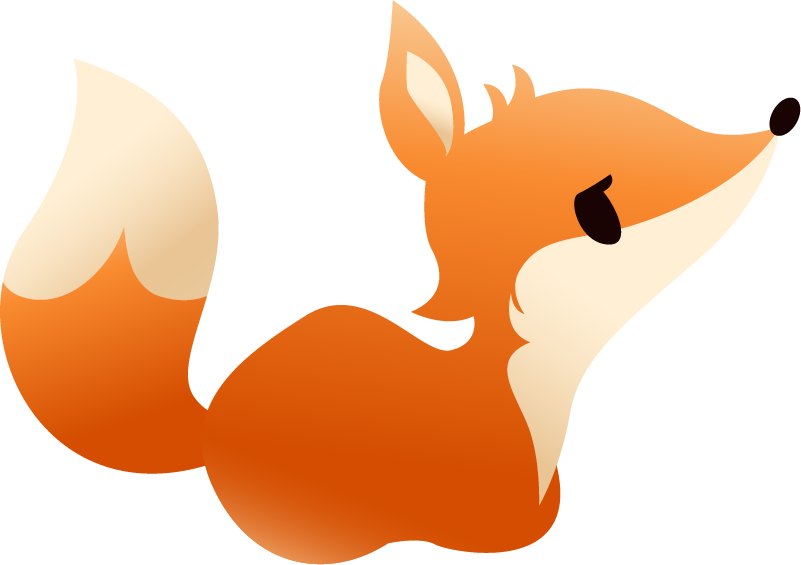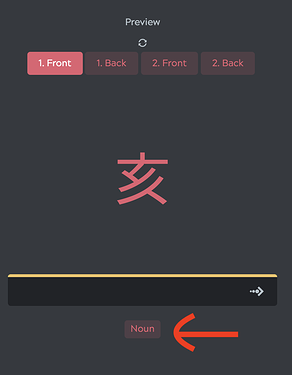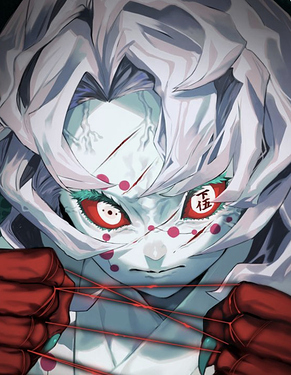Thanks!
Thank you so much for putting the work into making this and coming up with the mnemonics! I’m level 48 on WK… I’m definitely going to pick this up when I’m done!!
The only suggestion I would have is to have different coloring for kanji items and vocab items.
Also this is so perfect 
Nice, hope you enjoy. Feedback is welcomed  Glad the cover is a fit too.
Glad the cover is a fit too.
Given they are based on the Kitsun default templates, I’m not sure how this could be changed nor do I know custom template designs but it may be possible. I’m not a fan of the 90s color scheme WK uses but if there is something that could be changed, I’m up for it. As for now, single kanji vocab readings are distinguished by parts of speech tags like this:
Perhaps this is a dumb question but does every Kanji included in the deck have at least one vocab associated with it?
This is a great question actually. There are roughly a couple kanji per level with no associated vocab. The threshold was what was available in the Kitsun dictionary; if there were no vocab available (or of value), I did not add it in. I think this is ok as there are kanji even in WK levels 50-60 that have the same scenario (only kanji entry, no vocab).
Just a general comment in regards to vocab, I tried to pick the most useful words available but their is going to be rarely used vocab at this stage so much like WK, many are used to reinforce the meaning. However the power of Kitsun is that users can pick what they want to practice and it’s not gatekeeping further kanji study like WK. So I may suggest for users that once they are activating their new vocab level to review the list and feel free to hibernate what they don’t want to use. Of course if there useful vocab that is not listed, I’m happy to add it.
My plans to further developed the deck are:
- Add the radical shapes into the mnemonics as suggested. This is in progress, around ~L63 now.
- Add the 130 kanji Jinmeiyou. I looked through a few and the readings will be the critical element worth learning from. My issue right now, I don’t have any familiarity on what the most useful readings are. So I can just add the kanji as is (no mnemonic) if this is most practical and if you need this list in the near future. My concern is emphasizing the least frequent reading unless there is a resource that could filter this out but the point of the deck is have mnemonics and is most convenient to add these while generating the actual card.
- Add some more vocab sentences. I added some sentences in the first level but gave up when the vocab (and sentences) got really weird and the practical usage seemed of little value. But I think there are selective vocab where the sentence can still be of value but definitely not needed for every vocab entry IMO. And users are free to add any in the feedback too.
Yeah, but WK said at the time that they would eventually get entries (and just still haven’t). I think a single “useless” vocab may still be nice, just because it helps reinforce it and saves the user some effort, and overall doesn’t add too many cards anyways.
What we really need is a name associated to the kanji that is useful because more than likely these are Jinmeiyo kanji (which could be done in the entry or as a separate card). Here is the list on WK if you haven’t seen this thread already. A few have vocab but I didn’t hear anything regarding them adding any additional vocab…at least I’m not expecting it. I think their platform may not be ideal to this because you have to gatekeep levels and force users to learn vocab that maybe a native can’t even read or encounter unless they intend to add useful entries like common city or people names. Belthazar did a nice job adding notes here and is what I copied to my own WK entries.
I tried to be generous on the vocab but there were a number of entries that just didn’t have a dictionary entry for any words so I thought it was a reasonable threshold. I had some native feedback regarding the relative usefulness on the existing vocab so I didn’t want to mislead users of study time on arguably useless entries. But if there are vocab you (or anyone) would like added, I’m happy to do it.
I’m still of the assumption that the common ‘reading’ for Jinmeiyo is the most useful part of all in order for names, where meanings have a much less significant value. And there could negatives such as forcing vocab where the card will emphasize some esoteric reading that is hardly used when there is a more common name reading not being practiced.
Okay, I just started the deck, and I noticed that for 丑, it is tagged as “taught in undefined.” I assume that it is meant to signal the year it is taught in for Jouyou kanji, and I think it may just be best to add tags for jinmeiyou and hyougai for the ones that aren’t jouyou.
Edit: Also, I don’t know that teaching すく for 丞 is a great idea, considering I can’t find the reading on kanjipedia, and I don’t see 丞う on weblio. Literally the only reference I found for the reading is on jisho, which seems to be a mistake.
The only uses of 丞 outside of names that I can find at all are in 丞ける (the nuance to たすける of helping a superior with their work), 丞相 (historical term for the prime minister of the chinese empire), and 丞 (another position in the ancient Chinese bureaucracy). So たす, じょう, and しょう, appear to be the only “real readings.”
It is worth noting that I can’t find a word that uses しょう as a reading, but it is at least listed as a reading by kanjipedia, so I guess it counts.
These tags are auto generated through Kitsun’s dictionary which is presumably extrapolated from Jisho itself. I’ll default to the expertise of the dictionary tags unless grossly out of place and verified (ideally a native)
Its not a mistake, it can found as a boy’s first name. Not as common today, but found in Kabuki actors and that sort I’m told so the すく reading is useful and recognized by natives. 丞相 is the only vocab on file within Kitsun auto generated and which was added (users can decide to either study it or not, same with the kanji). In many cases nanori name readings are the most common and WK did this all the time without introducing names (there are the name decks that have been published here if preferred). I’m relying on the vocab bank within Kitsun which may or may not reinforce the vocab readings along with their provided readings. If I add the last 130 jinmeiyou, it’s going to be a similar scenario.
For anyone interested, I’m am tuning the deck; adding the radical shapes into the mnemonics as well as improving the mnemonics themselves (hope to have every kanji fullfilled too). This takes longer than expected (level 68 now) so thank you for your patience. I will try to add some more sentences to vocab (all is not possible) then I can start looking at the remaining jinmeiyou kanji list.
I honesty have no idea when some of these kanji will pop up sometimes, but fun to recognize them when they do. I’m probably slow catching up on Demon Slayer but Rui’s eyeball uses 伍 (level 61), which they say means he is lower ranked 5 in the Twelve Kizuki 下弦の伍(かげんのご)which makes sense to me 
That is すけ, not すく. As far as I’m aware, the only valid kunyomi/onyomi redings of the kanji are:
たす - found in 丞ける
じょう: found in 丞相 and 丞
しょう: No instances, but is still an accepted onyomi reading that could be used for proper nouns
Then, we also have nanori reading (which it doesn’t seem like any of your cards include) of すけ:
None of them is a kunyomi すく, which comes from jisho thinking that 丞う is a word that exists as a variant of 救う. I can’t find a single other site in Japanese or English with that, including kanjipedia, weblio, and wikitionary (or even jisho itself, since the すくう search doesn’t even give 丞う as an actual word)
Its on this weblio link as a kunyoumi reading and I’m assuming this how the naori reading got extrapolated. It’s probably not coincidental 丞 shares kunyomi readings of たす and すく with 救, though たす less often which then connects with 助 (which also connects again with すけ as a name); all very similar meanings.
So happy to reshape the mnemonic to じょう, I think this actually might be the most common upon inspection and just for names (otherwise not very useful from what I’m seeing). But I think the entries on すく(う)is correct here, I’m sure there is some etymology kanji story here. Does that work for you?
https://www.weblio.jp/content/すくう
Edit: I added an additional mnemonic for じょう
That is unsurprising because the kanji dictionary jisho uses is sourced to the same one jisho uses (KANJIDIC2). It is not found in kanjipedia (which is also the source of GOO辞書) or 辞典オンライン漢字辞典. The only other place I could find was the English and Japanese wiktionary, but even then, its entirely possible that it goes to KANJIDIC2 as well. Goolge advanced search for “丞う” gives just the wictionary pages, a weblio search that turns out example sentences that don’t include that, and instances with things like 丞(う or 丞-う. Later pages seem to be the same, except one private twitter post that I can’t actually view because it’s private, so I have no idea of context.
So yeah, I’d love it for the main reading to be changed to something else, since I’m skeptical the reading is real at all, even this dictionary, which lists 4 whole nanori readings, doesn’t have any reference to すく.
It’s in my Midori dictionary plus Jisho and Weblio link above so I don’t think it is fake. I added a じょう mnemonic as indicated above but these are only optional tools. There isn’t a main reading per se, this card alone has two Onyomi and three Kunyomi so use whatever is relevant to your goals.
Weblio and Jisho use the same source though, which is just KANJIDIC2, which is used because it is open source and thus free for them. I don’t know what Midori uses though, but I suspect the same thing, since the things I know that are sourced differently seem to not have it.
Another suggestion I would have is to maybe use 亘る as the vocab for it instead of 亘古, since 亘る seems fairly regularly used, and 亘古 isn’t even on JP weblio or GOO辞書, and my results from googling only show it from EN-JP dictionaries (which almost universally use JMDICT), and CN-JP dictionaries.
That’s a bug that I keep forgetting to take care of. Sorry about that.
Added it into L61, used 渡る entry and played w/ notes 
I see it in GOO辞書 for the entry for 亘. I got some hits when used with 亘古亘今 in wiki and a song title. But really it’s just an excuse to practice the onyomi (not to actually learn 亘古) which could have unknown usefulness but I don’t to deny it learners. So I think it’s best just to hibernate it on your side.
I would suggest this to all users as well, hibernate what you don’t want to practice for vocab and I’m happy to add additional vocab if requested. I don’t claim to be an expert on any of this material, just a learner like everyone else so suggestions are welcomed to further improve. If I were an expert, I wouldn’t be publishing decks (and probably be selling a product with a native team like WK  )
)
I’m getting some hits on 丞い or 丞った, not alot but I didn’t exhaust all verb conjugations so I can’t assume that because the dictionary form didn’t show doesn’t mean it doesn’t exist. It’s also in the All in One Kanji but I don’t know where they got their source. Unless an expert wants to chime in the validity of this reading as a dictionary flaw, I’d suggest just to using the じょう as your primary (I’d prefer not to deny it unless we are 100% certain).
YESSS! I Loved how they looked so i looked them up in wanikani(which they weren’t available in wk ofc)
I learned 壱弐参肆伍 from kimetsu no yaiba’s manga i recognize them now. While i can read this 下弦 and kinda understand it as lower rank but i don’t feel i know 弦 enough yet
It’s interesting because 弦 is known as ‘bowstring’ or ‘chord’ but you have a word like 弦月(げんげつ) and it becomes crescent moon and then 上弦 and 下弦 are first/last quarter



I’m never good at understanding these things, I’m guessing it’s a name or analogy for ranking (don’t see anything in the dictionary) perhaps because they are nocturnal as well (?).
I remember seeing them as higher military rank in jisho (i could be wrong) but i mostly saw them as first/last quarter etc.



